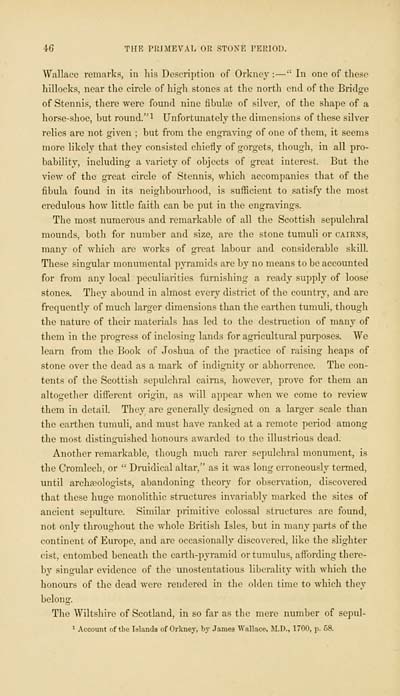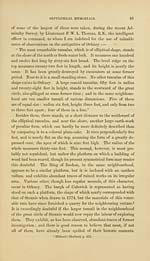Download files
Complete book:
Individual page:
Thumbnail gallery: Grid view | List view

46 THE PUniEVAL OIJ STONE PERIOD.
Wallace remarks, in his Description of Orknc}' : — " In one of these
hillocks, near the circle of high stones at the north end of the Bridge
of Stennis, there were found nine fibulse of silver, of the shape of a
horse-shoe, hut round." ^ Unfortunately the dimensions of these silver
relics are not given ; but from the engraving of one of them, it seems
more likely that they consisted chiefly of gorgets, though, in all pro-
bability, including a variety of objects of great interest. But the
view of the great circle of Stennis, which accompanies that of the
fibula found in its neighbourhood, is sufficient to satisfy the most
credulous how little faith can be put in the engravings.
The most numerous and remarkable of all the Scottish sepulchral
mounds, both for number and size, are the stone tumuli or cairns,
many of which are works of great labour and considerable skill.
These singular monumental pyramids are by no means to be accounted
for from any local peculiarities furnishing a ready supply of loose
stones. They abound in almost every district of the country, and are
frequently of much larger dimensions than the earthen tumuli, though
the nature of their materials has led to the destruction of many of
them in the progress of inclosing lands for agricultural purposes. We
learn from the Book of Joshua of the practice of raising heaps of
stone over the dead as a mark of indignity or abhorrence. The con-
tents of the Scottish sepulchral cainis, however, prove for them an
altogether diiFercnt origin, as will appear when we come to review
them in detail. They are generally designed on a larger scale than
the earthen tumuli, and must have ranked at a remote period among
the most distinguished honours awarded to the illustrious dead.
Another remarkable, though much rarer sepulchral monument, is
the Cromlech, or " Di-uidical altar,'"' as it was long erroneously termed,
until archaeologists, abandoning theory for observation, discovered
that these huge monolithic structures invariabl}'^ marked the sites of
ancient sepulture. Similar primitive colossal stnictures are found,
not only throughout the whole British Isles, but in many parts of the
continent of Europe, and are occasionally discovered, like the slighter
cist, entombed beneath the earth-pyramid or tumulu s, aifording there-
by singular e\adence of the imostentatious liberality with which the
honours of the dead were rendered in the olden time to which they
belong.
The Wiltshire of Scotland, in so far as the mere number of sepul-
1 Accomit of tlie Islands of Orkney, by James Wallace, M.D., 1700, p. 58.
Wallace remarks, in his Description of Orknc}' : — " In one of these
hillocks, near the circle of high stones at the north end of the Bridge
of Stennis, there were found nine fibulse of silver, of the shape of a
horse-shoe, hut round." ^ Unfortunately the dimensions of these silver
relics are not given ; but from the engraving of one of them, it seems
more likely that they consisted chiefly of gorgets, though, in all pro-
bability, including a variety of objects of great interest. But the
view of the great circle of Stennis, which accompanies that of the
fibula found in its neighbourhood, is sufficient to satisfy the most
credulous how little faith can be put in the engravings.
The most numerous and remarkable of all the Scottish sepulchral
mounds, both for number and size, are the stone tumuli or cairns,
many of which are works of great labour and considerable skill.
These singular monumental pyramids are by no means to be accounted
for from any local peculiarities furnishing a ready supply of loose
stones. They abound in almost every district of the country, and are
frequently of much larger dimensions than the earthen tumuli, though
the nature of their materials has led to the destruction of many of
them in the progress of inclosing lands for agricultural purposes. We
learn from the Book of Joshua of the practice of raising heaps of
stone over the dead as a mark of indignity or abhorrence. The con-
tents of the Scottish sepulchral cainis, however, prove for them an
altogether diiFercnt origin, as will appear when we come to review
them in detail. They are generally designed on a larger scale than
the earthen tumuli, and must have ranked at a remote period among
the most distinguished honours awarded to the illustrious dead.
Another remarkable, though much rarer sepulchral monument, is
the Cromlech, or " Di-uidical altar,'"' as it was long erroneously termed,
until archaeologists, abandoning theory for observation, discovered
that these huge monolithic structures invariabl}'^ marked the sites of
ancient sepulture. Similar primitive colossal stnictures are found,
not only throughout the whole British Isles, but in many parts of the
continent of Europe, and are occasionally discovered, like the slighter
cist, entombed beneath the earth-pyramid or tumulu s, aifording there-
by singular e\adence of the imostentatious liberality with which the
honours of the dead were rendered in the olden time to which they
belong.
The Wiltshire of Scotland, in so far as the mere number of sepul-
1 Accomit of tlie Islands of Orkney, by James Wallace, M.D., 1700, p. 58.
Set display mode to: Large image | Transcription
Images and transcriptions on this page, including medium image downloads, may be used under the Creative Commons Attribution 4.0 International Licence unless otherwise stated. ![]()
| Early Gaelic Book Collections > J. F. Campbell Collection > Archaeology and prehistoric annals of Scotland > (82) |
|---|
| Permanent URL | https://digital.nls.uk/78372278 |
|---|
| Description | Volumes from a collection of 610 books rich in Highland folklore, Ossianic literature and other Celtic subjects. Many of the books annotated by John Francis Campbell of Islay, who assembled the collection. |
|---|
| Description | Selected items from five 'Special and Named Printed Collections'. Includes books in Gaelic and other Celtic languages, works about the Gaels, their languages, literature, culture and history. |
|---|

